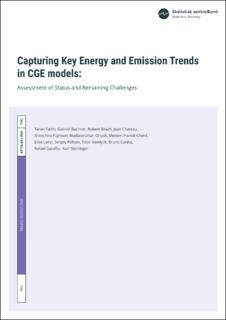| dc.contributor.author | Fæhn, Taran | |
| dc.contributor.author | Bachner, Gabriel | |
| dc.contributor.author | Beach, Robert | |
| dc.contributor.author | Chateau, Jean | |
| dc.contributor.author | Fujimori, Shinichiro | |
| dc.contributor.author | Ghosh, Madanmohan | |
| dc.contributor.author | Hamdi-Cherif, Meriem | |
| dc.contributor.author | Lanzi, Elisa | |
| dc.contributor.author | Paltsev, Sergey | |
| dc.contributor.author | Vandyck, Toon | |
| dc.contributor.author | Cunha, Bruno | |
| dc.contributor.author | Garaffa, Rafael | |
| dc.contributor.author | Steininger, Karl | |
| dc.date.accessioned | 2020-07-14T12:17:55Z | |
| dc.date.available | 2020-07-14T12:17:55Z | |
| dc.date.issued | 2020-07 | |
| dc.identifier.issn | 1892-753X | |
| dc.identifier.uri | https://hdl.handle.net/11250/2663967 | |
| dc.description | The present article is forthcoming in Journal of Global Economic Analysis vol. 5 (2020) No.1, 196-272. It is a product of fruitful discussions in the OECD/GTAP workshop "Shaping long-term baselines with CGE models” in the OECD, Paris, 24-25 January 2018, in particular, the break-out session on energy and the environment. | en_US |
| dc.description.abstract | Limiting global warming in line with the goals in the Paris Agreement will require substantial technological and behavioural transformations. This challenge drives many of the current modelling trends. This article undertakes a review of 17 state-of-the-art recursive-dynamic computable general equilibrium (CGE) models and assesses the key methodologies and applied modules they use for representing sectoral energy and emission characteristics and dynamics. The purpose is to provide technical insight into recent advances in the modelling of current and future energy and abatement technologies and how they can be used to make baseline projections and scenarios 20-80 years ahead. Numerical illustrations are provided. In order to represent likely energy system transitions in the decades to come, modern CGE tools have learned from bottom-up studies. Three different approaches to baseline quantification can be distinguished: (a) exploiting bottom-up model characteristics to endogenize responses of technological investment and utilization, (b) relying on external information sources to feed the exogenous parameters and variables of the model, and (c) linking the model with more technology-rich, partial models to obtain bottom-up- and pathwayconsistent parameters. | en_US |
| dc.language.iso | eng | en_US |
| dc.publisher | Statistisk sentralbyrå | en_US |
| dc.relation.ispartofseries | Discussion Paper;No. 936 | |
| dc.rights | Attribution-NonCommercial-NoDerivatives 4.0 Internasjonal | * |
| dc.rights.uri | http://creativecommons.org/licenses/by-nc-nd/4.0/deed.no | * |
| dc.subject | Computable general equilibrium models | en_US |
| dc.subject | Long-term economic projections | en_US |
| dc.subject | Energy | en_US |
| dc.subject | Technological change | en_US |
| dc.subject | Emissions | en_US |
| dc.subject | Greenhouse gases | en_US |
| dc.title | Capturing Key Energy and Emission Trends in CGE models: Assessment of Status and Remaining Challenges | en_US |
| dc.type | Working paper | en_US |
| dc.source.pagenumber | 76 | en_US |
| dc.relation.project | Norges Forskningsråd: 268200 | en_US |

